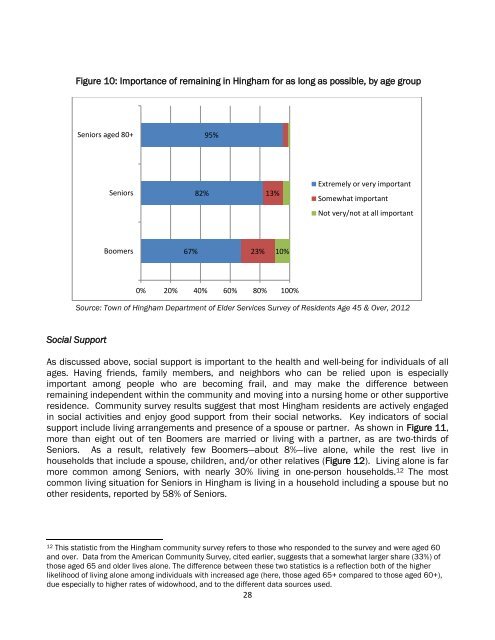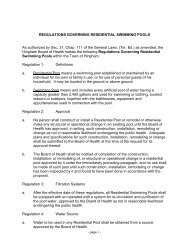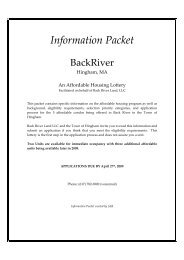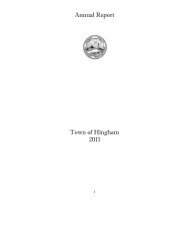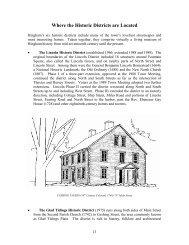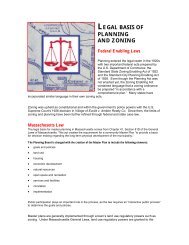Aging in Hingham - Town of Hingham Massachusetts
Aging in Hingham - Town of Hingham Massachusetts
Aging in Hingham - Town of Hingham Massachusetts
You also want an ePaper? Increase the reach of your titles
YUMPU automatically turns print PDFs into web optimized ePapers that Google loves.
Figure 10: Importance <strong>of</strong> rema<strong>in</strong><strong>in</strong>g <strong>in</strong> H<strong>in</strong>gham for as long as possible, by age groupSeniors aged 80+95%Seniors82%13%Extremely or very importantSomewhat importantNot very/not at all importantBoomers67%23%10%0% 20% 40% 60% 80% 100%Source: <strong>Town</strong> <strong>of</strong> H<strong>in</strong>gham Department <strong>of</strong> Elder Services Survey <strong>of</strong> Residents Age 45 & Over, 2012Social SupportAs discussed above, social support is important to the health and well-be<strong>in</strong>g for <strong>in</strong>dividuals <strong>of</strong> allages. Hav<strong>in</strong>g friends, family members, and neighbors who can be relied upon is especiallyimportant among people who are becom<strong>in</strong>g frail, and may make the difference betweenrema<strong>in</strong><strong>in</strong>g <strong>in</strong>dependent with<strong>in</strong> the community and mov<strong>in</strong>g <strong>in</strong>to a nurs<strong>in</strong>g home or other supportiveresidence. Community survey results suggest that most H<strong>in</strong>gham residents are actively engaged<strong>in</strong> social activities and enjoy good support from their social networks. Key <strong>in</strong>dicators <strong>of</strong> socialsupport <strong>in</strong>clude liv<strong>in</strong>g arrangements and presence <strong>of</strong> a spouse or partner. As shown <strong>in</strong> Figure 11,more than eight out <strong>of</strong> ten Boomers are married or liv<strong>in</strong>g with a partner, as are two-thirds <strong>of</strong>Seniors. As a result, relatively few Boomers—about 8%—live alone, while the rest live <strong>in</strong>households that <strong>in</strong>clude a spouse, children, and/or other relatives (Figure 12). Liv<strong>in</strong>g alone is farmore common among Seniors, with nearly 30% liv<strong>in</strong>g <strong>in</strong> one-person households. 12 The mostcommon liv<strong>in</strong>g situation for Seniors <strong>in</strong> H<strong>in</strong>gham is liv<strong>in</strong>g <strong>in</strong> a household <strong>in</strong>clud<strong>in</strong>g a spouse but noother residents, reported by 58% <strong>of</strong> Seniors.12 This statistic from the H<strong>in</strong>gham community survey refers to those who responded to the survey and were aged 60and over. Data from the American Community Survey, cited earlier, suggests that a somewhat larger share (33%) <strong>of</strong>those aged 65 and older lives alone. The difference between these two statistics is a reflection both <strong>of</strong> the higherlikelihood <strong>of</strong> liv<strong>in</strong>g alone among <strong>in</strong>dividuals with <strong>in</strong>creased age (here, those aged 65+ compared to those aged 60+),due especially to higher rates <strong>of</strong> widowhood, and to the different data sources used.28


